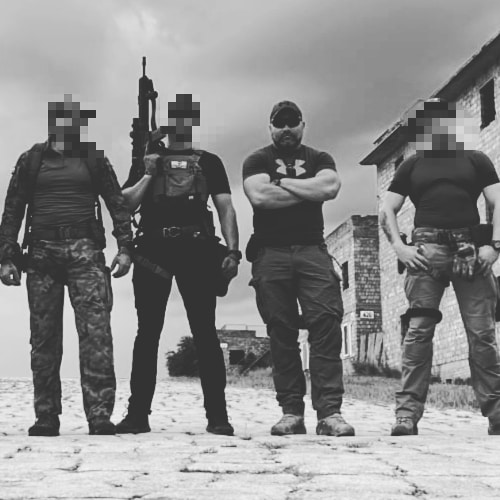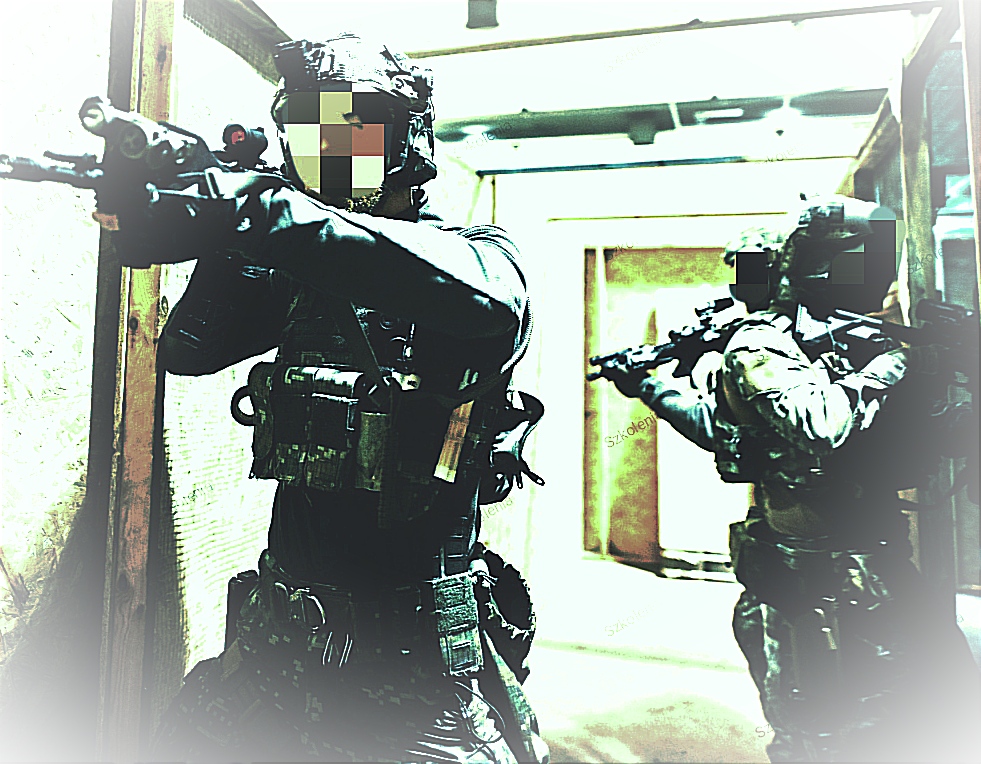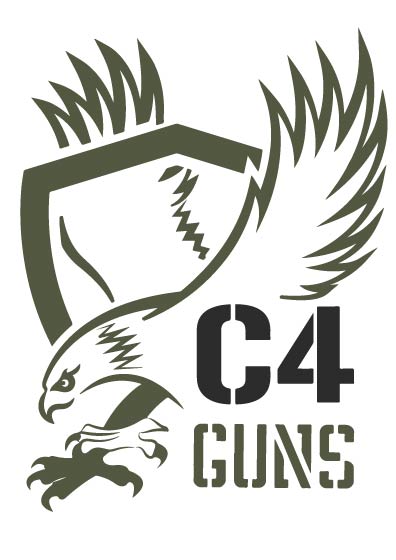

Krzysztof "Plaster"
Feel free to contact me!
Training options:
- Introductory training
- Basic pistol
- Intermediate pistol
- Advanced pistol
- Basic carbine
- Intermediate carbine
- Advanced carbine
- Static shooting
- Dynamic shooting
- Shooting from behind barriers
- Learning shooting rhythms
- Transition
- Home PROTECTION I, II, III
- VCQB I, II
Introductory training – one-day familiarization training, addressed to people who have not
fired a gun or people who have little shooting experience and want to learn the basic rules of
safe and effective firing in hazardous situations. Participation in these classes allows to
practice and master basic actions which are necessary for safe and effective use of
weapons in situations that force us to do it. Any participant of the training who wants to
continue the adventure with situational shooting can improve their skills as a part of
subsequent trainings.
Basic/ elementary level - is designed for people who have contact with weapons for the
first time in their life or their experience is small and they are interested in learning and
building a solid foundation of the use of a pistol or a carbine . At this level, the main
emphasis is on the foundations and building the right shooting base , allowing to develop
safe and good habits and the awareness in the use of firearms. The training consists of three
parts: theoretical, manual and ammunition firing combat.
Intermediate training – one-day training to learn situational shooting with a pistol or a
carbine from the basics to intermediate shooting and tactical issues. The training also
consists of three parts: theoretical, manual and firing with combat ammunition. The goal
training here is the acquisition of the skills in the safe use of short weapons and customs
guidance to fire in various shooting stances in place and from the screen. The trainee also
gets the opportunity to learn a proper handling of weapons in emergency situations, e.g.
weapon dysfunction, necessity of a clip replacement or unavailability of one of the hands.
Intermediate training ends with a practical exam checking the level of acquired shooting
skills. Participants of the training who obtain a positive result from the exam receive a
certificate confirming completion of training. In the event of failure to obtain a positive
result from the assessment test, the training participant receives a certificate confirming
only participation in the training and wishing to participate in the next levels of shooting
courses . They should repeat the training and retake the examination again.
Note: In order to participate in the intermediate training, you must have previously
completed training at the level of basics. To participate in advanced level training, you must
have previously completed training on the intermediate, etc. The interval between
individual trainings should not be longer than 3 months. In the case of a break lasting about
2-3 months, before applying for participation in the training on a higher level, it is suggested
to repeat the training at the last level. In case of more than 3 months interval , before
applying for participation in training at a higher level, it is required to repeat the training at
the level recently completed.
Shooting rhythmics - training for people who have completed a pre- intermediate course
and want to deepen their knowledge of the topic of firing more than one shot at the target
or fighting with several targets. It is also addressed to: advanced shooters who want to learn
the basics of multi-shots on different distances. The training consists of three parts:
theoretical, manual and firing with combat ammunition, conducted according to standards
developed for special forces operators. During the classes we will focus primarily on the
correct work on the trigger tongue, work on the trigger reset and split between arrows.
Building habits in small steps will not allow mistakes to occur. Errors that are duplicated on
subsequent stages can be difficult to eliminate. We will start by repeating selected elements
from the pre-intermediate level (correct shooting base, removal of weapon dysfunctions,
forced attitudes). After the reminder introduction, we focus on the rhythmic shooting, i.e.
firing multiple shots at one or more targets, shooting on different distances, assessment of
own capabilities, work with a shooting timer.
Training in shooting rhythms - ends with a practical exam to check the level of acquired
shooting skills. Training participants who obtain a positive result from the exam receive a
certificate confirming the completion of the training. In the event of failure to obtain a
positive result from the assessment test, the training participant receives a certificate
confirming only participation. Wishing to participate in the next levels of shooting courses
demands repeating the training and rejoining the next levels of shooting courses plus
retaking the exams.
Note: In order to participate in the shooting rhythmics training, you must have previously
completed training at the pre-intermediate level. To participate in advanced level training,
you must have previously completed training on the intermediate, etc. The interval between
individual trainings should not be longer than 3 months. In the case of a break lasting about
2-3 months, before applying for participation in the training on a higher level, it is suggested
to repeat the training at the last level. In case of more than 3 months interval , before
applying for participation in training at a higher level, it is required to repeat the training at
the level recently completed.
Advanced training – one-day training to learn situational shooting with a pistol or a carbine
from intermediate to advanced shooting and tactical issues. Training also consists of three
parts: theoretical, manual and firing with combat ammunition. The aim of the training is to
acquire the ability to safely use a handgun or carbine and to conduct accurate fire in
different shooting stances in place, from behind the screen , but above all in motion.
Participants of the training repeat the proper handling of weapons in emergency situations,
e.g. weapon dysfunction, replacing the magazine or the unavailability of one of the hands.
Advanced training also ends with a practical exam to check the level of acquired skills
shooting. Participants of the training who obtain a positive result from the exam receive a
certificate confirming completion of training. In the event of failure to obtain a positive
result from the assessment test, the training participant receives a certificate confirming
only participation in the training and wishing to participate in the next levels of shooting
courses they should repeat the training and retake the examination again.
Transition (transition from primary to spare gun ) - After acquiring the ability to work on
barricades and moving around, the next step is to learn to make quick decisions during the
fight. We will show you when it is worth to go ahead with spare gun, when to try to
remove the jam, and when to hide or run. We will teach you simple and effective procedures
thanks to which you will increase your chances during the fight. Training Transition ends with
a practical exam checking the level of acquired shooting skills. Participants of the training
who obtain a positive result from the exam receive a certificate confirming completion
training. In the event of failure to obtain a positive result from the assessment test, the
training participant receives a certificate confirming only participation. Then they should
repeat the training and retake the exam.
Note: To participate in the Transition training, you must have previously completed
advanced level training both from a pistol and a carbine. To participate in the advanced level
training, you must first take the intermediate level training, etc. The break between
individual trainings should not be longer than 3 months. In the case of a break of
approximately 2-3 months, before applying to participate in the higher level training is
suggested to repeat the training at the level recently completed. In case of a break lasting
more than 3 months, before applying for participation in higher training level it is required
to repeat the training at the level recently completed.
Back to basics - training addressed to advanced and intermediate shooters. This time there
will be no tactics or flashy looking drills. There will be hard, reliable work on the basics
especially if more bad habits you have managed to develop along with the conviction of
your own shooting fucking talent. However, you can be sure that after this experience you
will look at shooting training differently. Back to basics takes a full weekend and includes a
minimum of 8 hours of classes each day. On Saturday we work with a pistol, on Sunday with
a rifle. Every day you will fire a minimum of 400 pieces of ammunition, carried out carefully
prepared and properly planned exercises. We will also answer the following questions:
How do I upgrade my default skill level?
What to do to shoot better: more accurately and faster?
How to practice to work on a weapon more effectively ?
Training program:
• pistol at a distance of 0-25m
• rifle at a distance of 0-50m
• precision of the shot
• effective weapon handling technique
• rules of shooting within a certain time limit
• correct use of sights and various sight images
• optimal hardware configuration
• verification of the current level of the shooter and elements to improve
• performance-based training modelled on Tasks, Conditions & Standards
Home Protection is a training in the field of home defense of us and our loved ones. The
mere possession of weapons at home is not enough to effectively defend against an
aggressive attack on our home. Here you learn how effectively and safely fight and defend
your family members in your own home, how to use the familiarity of the rooms, what is the
one-man tactics of fighting indoors, whether I have allies at home and how to use them,
how to shoot at short distance surrounded by your loved ones. Based on the tactics of
special forces Indoor Combat (CQB) we have created a unique training program that will
prepare you to confront bandits in your own home. During the training, we focus on
realism. After this training, you will look at your skills differently The house and its
surroundings.
DUE TO THE COMPLEXITY OF THE PROBLEM, HOME PROTECTION TRAINING IS DIVIDED INTO
3 STAGES
HOME PROTECTION STAGE I
- analysis of problems occurring in the place of residence
- storing weapons and ammunition at home and protecting the house
-Combat shooting course developed by and for operators of American special forces.
Training program has been arranged in a way that guarantees constant development. During
the training, we primarily teach how to fight with the use of firearms, so the basis is a good
mastery of the foundations of combat shooting! Five points of defense and protection of
family members from a brutal invasion of the house (Home defense)
- tactics of fighting indoors and rescuing family members (one man tactics) - cooperation
with the police, group protection.
HOME PROTECTION STAGE II
During this training, we improve indoor combat techniques in more complex scenarios. We
increase the level of difficulty by adding props, the number of rooms and attackers is also
increased.
HOME PROTECTION STAGE III
An important element of this training is learning to work on a flashlight attached to a
weapon and held in the hand. Knowing your own home as an element of advantage,
protecting and rescuing family members in hostage situations improving acquired skills
during various scenarios.
What to bring?
All participants: comfortable everyday outfit (preferably tracksuits or pajamas, flip-flops)
Participants with their own weapon: a semi-automatic pistol, flashlight (EDC or on weapons)
150 pcs. Ammunition
2 magazines
EDC holster
Note: In order to participate in the HOME PROTECTION training, you must have previously
completed training at the level of advanced with a pistol . To participate in the advanced
level training, you must first take intermediate level training, etc. The break between
individual trainings should not be longer than 3 months. In the case of a break of
approximately 2-3 months, before applying to participate in the higher level training it is
suggested to repeat the training at the level recently completed. In the case of a break
lasting more than 3 months, before applying for participation in higher training level it is
required to repeat the training at the level recently completed.
VCQB Level I- Training focusing on positional shooting, fighting in and around vehicles.
Participants will push the boundaries of "traditional" cover and camouflage using the car's
cover. Exercises will involve the critical use of weapons while combating threats in-around
vehicles, from- over and below vehicles with great emphasis on the safe use of weapons in a
life-threatening situation among outsiders.
VCQB level II - Training focusing on positional shooting, fighting in and around vehicles.
Participants will push the boundaries of "traditional" cover and camouflage using the car's
cover. Exercises will involve the critical use of weapons while combating threats in- around
vehicles, from- over and below vehicles, with great emphasis on the safe use of weapons in a
situation of danger to one's own life, people traveling with us as well as outsiders. The class
will end with a demonstration of the vehicle's ballistics by firing ammunition of different
calibers around it and at directly , we will show ballistic deflection, deformation, penetration
and the final effect in direct correlation with different parts of the vehicle.
Note: To participate in VCQB training, you must have previously completed advanced level
training both from a pistol and a carbine. To participate in the advanced level training, you
must first take intermediate level training, etc. The break between individual trainings
should not be longer than 3 months. In the case of a break of approximately 2-3 months,
before applying to participate in the higher level training it is suggested to repeat the
training at the level recently completed. In the case of a break lasting more than 3 months,
before applying for participation in higher training level it is required to repeat the training
at the level recently completed.
NV–one-day additional training addressed to persons who have obtained a certificate
confirming completion training at an advanced level with both pistol and carbine, wishing to
acquire or develop skills of how to use these weapons. During the training, participants have
the opportunity to learn how to conduct fire in conditions of limited visibility and at night,
using hand flashlights or flashlights integrated into weapons (tactical) and laser pointers.
Note: To participate in NV training, you must have previously completed training at an
advanced level of both a pistol and a carbine. To participate in advanced level training, you
must have previously completed training at the intermediate level, etc. The break between
individual trainings should not be longer than 3 months. In the case of a break lasting about
2-3 months, before applying for participation in the training on a higher level it is suggested
to repeat the training at the level recently completed. In case of interruption lasting more
than 3 months, before applying for participation in training at




